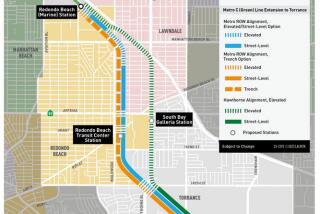CALIFORNIA ALBUM : An Uphill Ride : Transit: BART once was reviled. Now it is used by nearly half the rush hour commuters who cross San Francisco Bay. Welcome to your new subway, Los Angeles. But it may take a while to grow on you.
- Share via
SAN FRANCISCO — To: Los Angeles
From: The Bay Area
Re: Life With a Subway
Welcome, welcome, welcome! We hear you’ve taken the pledge and joined the sorority of cities with subways. Mazel tov and good luck; history suggests you’ll need it.
We don’t want to wreck the honeymoon or anything, but we remember well the giddy expectations that accompanied the debut of our pioneering Bay Area Rapid Transit system back in 1972. What many of us remember better, unfortunately, are the gloomy mornings that followed.
Don’t get us wrong--we’re extremely grateful to have BART, as we fondly call our 71 1/2-mile system of track and snub-nosed trains. Each weekday, 260,000 of us queue up to step aboard, and BART usually rewards us with a quiet, speedy, affordable, stress-free ride to work.
Last year we celebrated our 20th anniversary, and marked another milestone as well: During rush hour, nearly half of the commuters traveling between the East Bay and San Francisco are carried by BART. Transit experts, who have been stingy with affection for our rail line, are quite impressed by this.
But reaching this happy plateau took two decades, and we’re not going to kid you--the ride was bumpy much of the time. Early on there were balky cars, doors that refused to open, a fire in the tube beneath San Francisco Bay, and exasperating computer glitches that stalled and stranded us on the tracks.
The technical bugs are behind us now, but finding parking at most stations remains an irritating challenge. As for the designers’ predictions that peak-hour trains would run every 90 seconds and everybody would have a seat--HA!
It’s sardine city during crunch time, and waits of five or 10 minutes are a staple of BART life.
Dan Asvitt, an insurance claims manager who has ridden BART 30 miles to work each morning for five years, speaks for a big crowd of us as he reflects on the pros and cons of the Bay Area subway experience.
“You’re definitely glad you have it . . . but you’ve got to be patient with the system,” Asvitt wants Angelenos to know. “It’s simply not going to be everything it’s cracked up to be.”
*
We entered the subway era on Sept. 11, 1972, when Gertrude Guild of Oakland slipped her magnetically coded ticket into an automatic fare gate and became BART’s first paying passenger.
With a price tag of $1.6 billion, BART opened way over budget. But we were proud of the Buck Rogers look of its cars, and enamored with its stylish stations.
Ours was the first new transit system built in this nation in 60 years, we boasted. It was ambitious, “space-age.” President Richard Nixon even came for a ride.
Five days after his visit, however, a train hurtled off a track and crashed into a parking lot. Nobody died, but the so-called “Fremont Flier” episode made us a little squeamish: Was BART--the most highly automated transit system ever built at the time--really safe?
Soon other problems stoked our angst. The sophisticated control computers proved capricious, failing to detect trains dead on the tracks or spotting “ghost trains,” which caused aggravating slowdowns. Faulty brakes required speed reductions in rainy weather. Chronic breakdowns made many of us late for work, eroding our faith.
Then, in 1979, an electrical short circuit caused a fire in the tube under the bay linking Oakland and San Francisco. A firefighter died from inhaling poison smoke, seven passengers were injured, and, for a good long while, the rest of us got clammy every time our train’s nose ducked into that underwater tunnel.
Reliability gradually improved, but most of us trace BART’s turning point to the Loma Prieta earthquake of Oct. 17, 1989. With the Bay Bridge down and crucial sections of other freeways closed for repairs, BART was unscarred and bore a crushing load of commuters in the days after the quake--and bore it well.
Thousands of new riders became permanent converts. We’ve still got gripes, but our confidence in the system has been high ever since.
*
So enjoy your new toy, Los Angeles. But beware the perils that lie ahead, sooner than you might think.
Recently, the BART czars began warning us that our rail line is showing its age. It will cost $1 billion, the engineers say, to keep the system humming safely along.
A derailment that injured 14 people just before Christmas “was a wake-up call,” said BART General Manager Frank Wilson. “The system was saying, ‘Pay attention, because I’m in need of some work.’ ”
And so begins a new cycle for BART. A fare increase will likely be sought for the rehabilitation, a prospect that already has us grumbling as we read about it in our morning paper on the train.
Meanwhile, BART is branching out. One new leg is reaching south toward San Francisco Airport, while two more are heading for the East Bay suburbs of Pleasanton and Pittsburg.
“Today, everybody wants BART,” said Nello Bianco, a veteran BART board member. “Used to be, a politician who was in trouble around here needed only to attack BART to become a hero.”
It’s funny, Bianco mused, how things change.
Bay Area Rapid Transit
The BART system, in its 21st year, has weathered early troubles to become a hit with Bay Area commuters. Weekly ridership is 260,000, and there are plans to expand the system’s four lines toward San Francisco International Airport and distant suburbs.
BART
Miles: 71
Stations: 34
More to Read
Sign up for Essential California
The most important California stories and recommendations in your inbox every morning.
You may occasionally receive promotional content from the Los Angeles Times.













